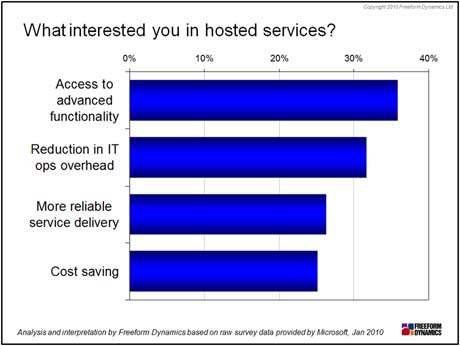In earlier articles in this workshop we reported on research carried out by Freeform Dynamics that organisations are not entirely happy with the systems management tools available to them to help administer the IT infrastructure in day-to-day service delivery.
At the same time, we know that operations staff are working under great stress as they seek to keep business services running as cost effectively as possible, all the while being faced with increasing demands for availability, service quality and flexibility.
Our studies tell us that many companies have a mixed bag of servers running in their data centres and computer rooms. Whether it is servers from multiple vendors, or just a mixture of servers that vary in age, performance, power consumption and capabilities, getting on top of managing all of them can be a challenge. With IT staff already working under immense pressure, could bringing in an external partner help smooth operational service delivery? It is worth remembering that external partners come in all shapes and sizes. These include, for example, professional services to define and implement systems, managed services to run systems delivered by the vendor themselves or a qualified services partner, as well as options such as externally resourced Infrastructure as a Service and SaaS models.
This begs the question whether bringing in any such services a dream partnership made in heaven, or is it more akin to a marriage made in hell? For any of these options to be effective there is great incentive to select the right partner, otherwise the best that might be achieved would be to keep running into the same old problems, but maybe with someone else taking the blame. Whilst this might be a politically convenient ‘pass the buck’ clause – not our fault, it’s our supplier – unless there is proper accountability and monitoring it is likely that little, if any, business benefit will be achieved with this approach.
Or worse, introducing a third party also introduces an element of risk, given that they may not necessarily grasp the full scope of requirements to be dealt with.
It really is important that any external service be approached with a suitable attitude. Selecting a partner to reduce costs is one approach, but while doing “the same for less” may help with budget control, it will do nothing to increase flexibility or exploit new services. With this in mind it is enlightening to look at the chart below which tells us why some small and mid-sized organisations are interested in hosted services.

As can be seen, “cost savings” was the least common response, whilst gaining access to advanced functionality was the major interest for over a third of respondents from around the globe. Indeed, the direct saving of money is also comfortably behind the requirement for more reliable service delivery. The fact that reducing operational overheads is rated above cost saving may reflect the politics of running IT today, whereby some organisations do not naturally associate the value of IT services delivered by IT with the cost of running those systems.
It is my belief that the use of external IT services will increase in organisations of all sizes over the coming years, but it will not be an overnight revolution. Equally, I would maintain that the use of managed services to help keep systems operational inside the business will also increase, especially to help organisations exploit new systems for which they do not have internal skills readily to hand.
But for any of these options to be employed to increase business value, the suppliers of the services will need to earn the trust of their customers. Only with all parties working together smoothly can IT service delivery move forward, rather than use using external services as a substitute to take the blame. At the same time, IT and its business partners must recognise that the most effective use of external services is achieved when reducing costs is not the primary driver, but rather where getting access to new services is the primary goal.